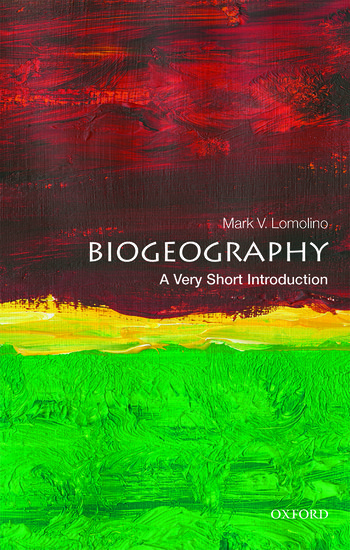Home >
A Very Short Introduction >
Biogeography (Geography)
A Very Short Introduction | Geography
Biogeography
ISBN: 9780198850069
Series: A Very Short Introduction
Biogeography (Geography)
A Very Short Introduction Biogeography (Geography) Media > Books > Non-Fiction > Education Books Expect Delays of Up to 4 Weeks| Order Below |
ISBN
9780198850069 (10-digit ISBN: 0198850069)
- Description
- Key Features
- Series Description
- Table of Contents
- Explains how our ability to place life in an explicit geographic context is key to understanding the natural world
- Shows how the tools of biogeography are essential for us to develop effective strategies for conserving the great menagerie of life across our planet
- Explains how the geological and evolutionary history of our planet are interconnected
Biogeography is the study of geographic variation in all characteristics of life - ranging from genetic, morphological and behavioural variation among regional populations of a species, to geographic trends in diversity of entire communities across our planet's sufrace. From the ancient hunters and gatherers to the earliest naturalists, Charles Darwin, Alfred Russel Wallace, and scientists today, the search for patterns in life has provided insights that proved invaluable for understanding the natural world. And many, if not most, of the compelling kaleidoscope of patterns in biological diversity make little sense unless placed in an explicit geographic context.
The Very Short Introduction explains the historical development of the field of biogeography, its fundamental tenets, principles and tools, and the invaluable insights it provides for understanding the diversity of life in the natural world. As Mark Lomolino shows, key questions such as where species occur, how they vary from place to place, where their ancestors occurred, and how they spread across the globe, are essential for us to develop effective strategies for conserving the great menagerie of life across our planet.
Oxford's Very Short Introductions series offers concise and original introductions to a wide range of subjects--from Islam to Sociology, Politics to Classics, Literary Theory to History, and Archaeology to the Bible.
Not simply a textbook of definitions, each volume in this series provides trenchant and provocative--yet always balanced and complete--discussions of the central issues in a given discipline or field. Every Very Short Introduction gives a readable evolution of the subject in question, demonstrating how the subject has developed and how it has influenced society. Eventually, the series will encompass every major academic discipline, offering all students an accessible and abundant reference library.
Whatever the area of study that one deems important or appealing, whatever the topic that fascinates the general reader, the Very Short Introductions series has a handy and affordable guide that will likely prove indispensable.
Please note: As this series is not ELT material, these titles are not subject to discount.
Acknowledgements
List of illustrations
1: Biological diversity and the geography of nature
2: Dynamics maps of a dynamic planet
3: Geography of diversification
4: Retracing evolution across space and time
5: The geography of biological diversity
6: Macroecology and the geography of micro-evolution
7: The geographic and ecological advance of humanity
Further reading
Index
Biogeography is the study of geographic variation in all characteristics of life - ranging from genetic, morphological and behavioural variation among regional populations of a species, to geographic trends in diversity of entire communities across our planet's sufrace. From the ancient hunters and gatherers to the earliest naturalists, Charles Darwin, Alfred Russel Wallace, and scientists today, the search for patterns in life has provided insights that proved invaluable for understanding the natural world. And many, if not most, of the compelling kaleidoscope of patterns in biological diversity make little sense unless placed in an explicit geographic context.
The Very Short Introduction explains the historical development of the field of biogeography, its fundamental tenets, principles and tools, and the invaluable insights it provides for understanding the diversity of life in the natural world. As Mark Lomolino shows, key questions such as where species occur, how they vary from place to place, where their ancestors occurred, and how they spread across the globe, are essential for us to develop effective strategies for conserving the great menagerie of life across our planet.
Key Features
- Explains how our ability to place life in an explicit geographic context is key to understanding the natural world
- Shows how the tools of biogeography are essential for us to develop effective strategies for conserving the great menagerie of life across our planet
- Explains how the geological and evolutionary history of our planet are interconnected
Series Description
Oxford's Very Short Introductions series offers concise and original introductions to a wide range of subjects--from Islam to Sociology, Politics to Classics, Literary Theory to History, and Archaeology to the Bible.
Not simply a textbook of definitions, each volume in this series provides trenchant and provocative--yet always balanced and complete--discussions of the central issues in a given discipline or field. Every Very Short Introduction gives a readable evolution of the subject in question, demonstrating how the subject has developed and how it has influenced society. Eventually, the series will encompass every major academic discipline, offering all students an accessible and abundant reference library.
Whatever the area of study that one deems important or appealing, whatever the topic that fascinates the general reader, the Very Short Introductions series has a handy and affordable guide that will likely prove indispensable.
Please note: As this series is not ELT material, these titles are not subject to discount.
EASY ORDER FORM
PRICES LISTED INCLUDE CONSUMPTION TAX
Price Before Tax:
¥1,790


